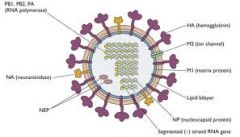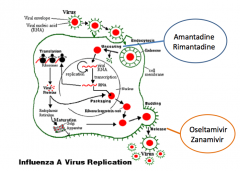![]()
![]()
![]()
Use LEFT and RIGHT arrow keys to navigate between flashcards;
Use UP and DOWN arrow keys to flip the card;
H to show hint;
A reads text to speech;
12 Cards in this Set
- Front
- Back
|
Influenza virus
enveloped virus- outer layer is a lipid membrane taken from host cell in which the virus multiplies. |

|
|
|
HA (Hemaglglutinin) and NA( Neuraminidase)
|
Inserted into the lipid membrane are ‘spikes’, which are proteins – actually glycoproteins, because they consist of protein linked to sugars – known as HA (hemagglutinin; binds to cellular recpeptor- sialic acid) and NA (neuraminidase).
important in immune response; antibodies (proteins made by us to combat infection) against these spikes may protect against infection. The NA protein is the target of the antiviral drugs Relenza and Tamiflu. |
|
|
M2 Protein
|
Also embedded in the lipid membrane is the M2 protein, which is the target of the antiviral adamantanes – amantadine and rimantadine.
|
|
|
M1 (Matrix) Protein
|
Beneath the lipid membrane is a viral protein called M1, or matrix protein. This protein, which forms a shell, gives strength and rigidity to the lipid envelope.
|
|
|
PB1, PB2, PA, NP
|
Within the interior of the virion are the viral RNAs – 8 of them for influenza A viruses. These are the genetic material of the virus; they code for one or two proteins. Each RNA segment, as they are called, consists of RNA joined with several proteins shown in the diagram: B1, PB2, PA, NP( nucleocapsid protein; stabalizes RNA). These RNA segments are the genes of influenza virus.
|
|
|
NEP
|
interior of the virion also contains another protein called NEP. Nuclear export protein, replicates in nucleus.
|
|
|
Where and who does it infect?
|
can infect H20 and aquatic creatures- pratically every animal is susceptible which is why it spreads so easily. It also lives on inanimate objects.
|
|
|
IAV Replication
|

|
|
|
IAV
|
Three types: A, B, C
• Hemagglutinin –16 –Sialic acid • α2,6-human • α2,3-bird • Neuraminidase –9 |
|
|
Antigenic Drift/Shift
|

|
|
|
IAV Complications
|
• Primary viral pneumonia
• Secondary bacterial pneumonia • Reye syndrome – brain swelling; liver degeneration –Aspirin = disease co-factor |
|
|
Influenza Vaccine
|
• Live-attenuated – “flu mist”
• Inactivated –Formaldehyde-treated –IM injection –60-90% efficacy –Annual |

